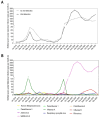The Impact of the COVID-19 Pandemic on the Clinical and Epidemiological Profile of Severe Acute Respiratory Infection in Bahia, Brazil: A Comparative Analysis of Pre- and Post-Pandemic Trends
- PMID: 40143317
- PMCID: PMC11946068
- DOI: 10.3390/v17030389
The Impact of the COVID-19 Pandemic on the Clinical and Epidemiological Profile of Severe Acute Respiratory Infection in Bahia, Brazil: A Comparative Analysis of Pre- and Post-Pandemic Trends
Abstract
In recent years, the incidence of Severe Acute Respiratory Infection (SARI) has increased due to the emergence of SARS-CoV-2. However, the impact of the COVID-19 pandemic extends beyond mortality rates. Recent analyses suggest that the introduction and spread of SARS-CoV-2 have significantly affected the epidemiology of other key respiratory viruses, such as influenza virus (FLUV), respiratory syncytial virus (RSV), and rhinovirus (RV). These changes raise new questions about the dynamics and incidence of post-COVID-19 respiratory infections, as well as potential alterations in symptom profiles and clinical outcomes. In this study, we analyzed data from the Epidemiological Surveillance Information System of Respiratory Viral Agents (SIVEP-Gripe), established by the Brazilian Ministry of Health, to examine the profile of SARI before and during the COVID-19 pandemic in Brazil. Our data reveal a distinct epidemiological pattern, with a significant decrease in FLUV notifications during the pandemic, accompanied by peaks in RSV and RV cases in late 2020. Additionally, there was a shift in the age distribution of RSV and other viral infections, with individuals infected during the pandemic being older than those infected before the pandemic. Interestingly, the introduction and spread of SARS-CoV-2 in Bahia State resulted in a reduction in the frequency of symptoms associated with non-SARS-CoV-2 SARI, without altering clinical outcomes. Our findings suggest that the circulation of SARS-CoV-2 has contributed to a clinical and epidemiological shift, particularly for FLUV, RSV, and other viruses, marked by a reduction in symptoms such as fever, dyspnea, respiratory distress, and the need for ventilatory support. The underlying mechanisms driving these changes remain unclear. These insights are crucial for public health authorities and policymakers to refine surveillance strategies and enhance control measures for respiratory viruses, particularly those causing SARI.
Keywords: SARI; SARS-CoV-2; influenza virus; respiratory syncytial virus; seasonality; symptoms.
Conflict of interest statement
The authors declare no conflicts of interest.
Figures





Similar articles
-
Shifts in Influenza and Respiratory Syncytial Virus Infection Patterns in Korea After the COVID-19 Pandemic Resulting From Immunity Debt: Retrospective Observational Study.JMIR Public Health Surveill. 2025 Jul 23;11:e68058. doi: 10.2196/68058. JMIR Public Health Surveill. 2025. PMID: 40700345 Free PMC article.
-
Physical interventions to interrupt or reduce the spread of respiratory viruses.Cochrane Database Syst Rev. 2023 Jan 30;1(1):CD006207. doi: 10.1002/14651858.CD006207.pub6. Cochrane Database Syst Rev. 2023. PMID: 36715243 Free PMC article.
-
Risk of Incidence and Lethality by Etiology of Severe Acute Respiratory Syndrome in Hospitalized Children Under 1 Year of Age in Brazil in 2024: A Cross-Sectional Study.Trop Med Infect Dis. 2025 Jun 14;10(6):168. doi: 10.3390/tropicalmed10060168. Trop Med Infect Dis. 2025. PMID: 40559735 Free PMC article.
-
Prevalence of influenza A and B and respiratory syncytial virus infections before and during COVID-19 pandemic in the pediatric population in Lebanon: A retrospective study.PLoS One. 2025 Jun 6;20(6):e0325001. doi: 10.1371/journal.pone.0325001. eCollection 2025. PLoS One. 2025. PMID: 40478824 Free PMC article.
-
Antibody tests for identification of current and past infection with SARS-CoV-2.Cochrane Database Syst Rev. 2022 Nov 17;11(11):CD013652. doi: 10.1002/14651858.CD013652.pub2. Cochrane Database Syst Rev. 2022. PMID: 36394900 Free PMC article.
References
-
- Fitzner J., Qasmieh S., Mounts A.W., Alexander B., Besselaar T., Briand S., Brown C., Clark S., Dueger E., Gross D., et al. Revision of clinical case definitions: Influenza-like illness and severe acute respiratory infection. Bull. World Health Organ. 2018;96:122–128. doi: 10.2471/BLT.17.194514. - DOI - PMC - PubMed
-
- World Health Organization (WHO) Global Influenza Programme. [(accessed on 12 February 2025)]. Available online: https://www.who.int/teams/global-influenza-programme/surveillance-and-mo....
Publication types
MeSH terms
Grants and funding
LinkOut - more resources
Full Text Sources
Medical
Miscellaneous

